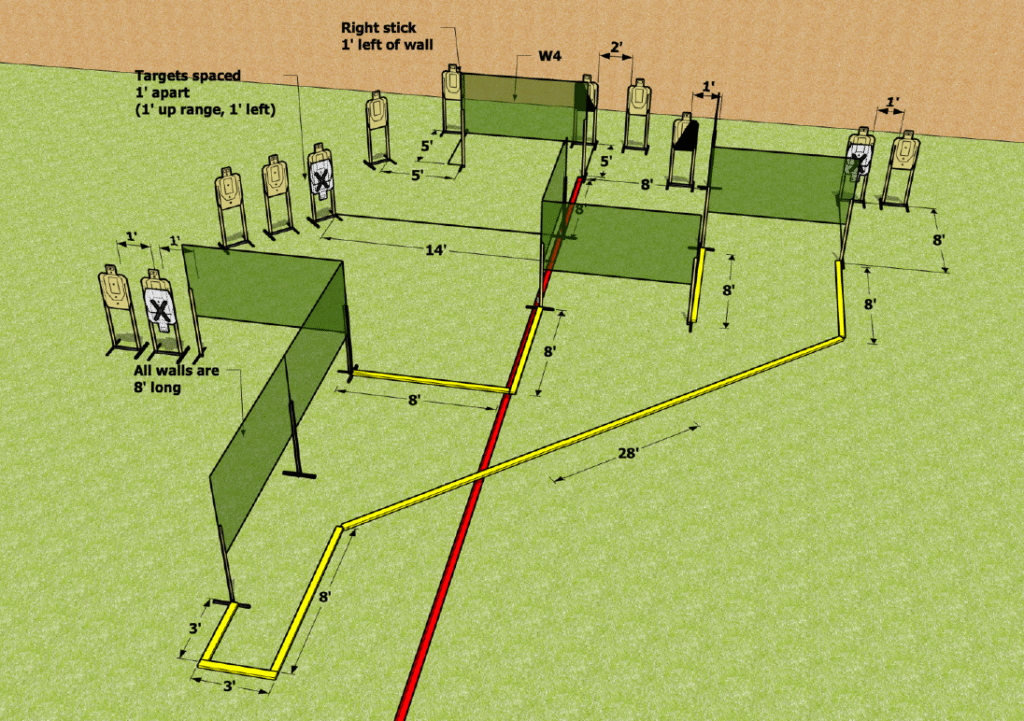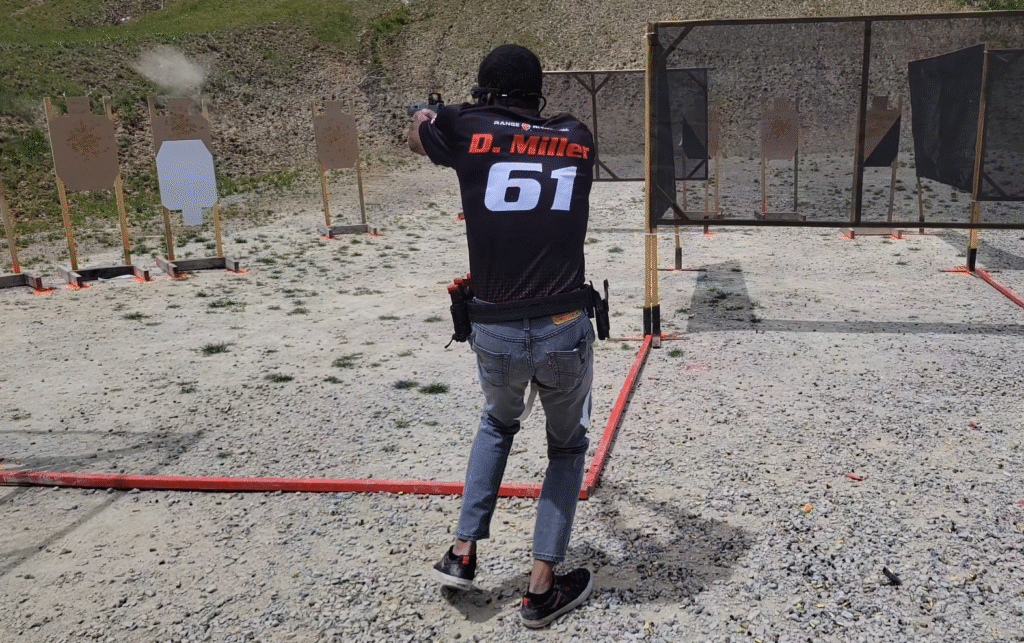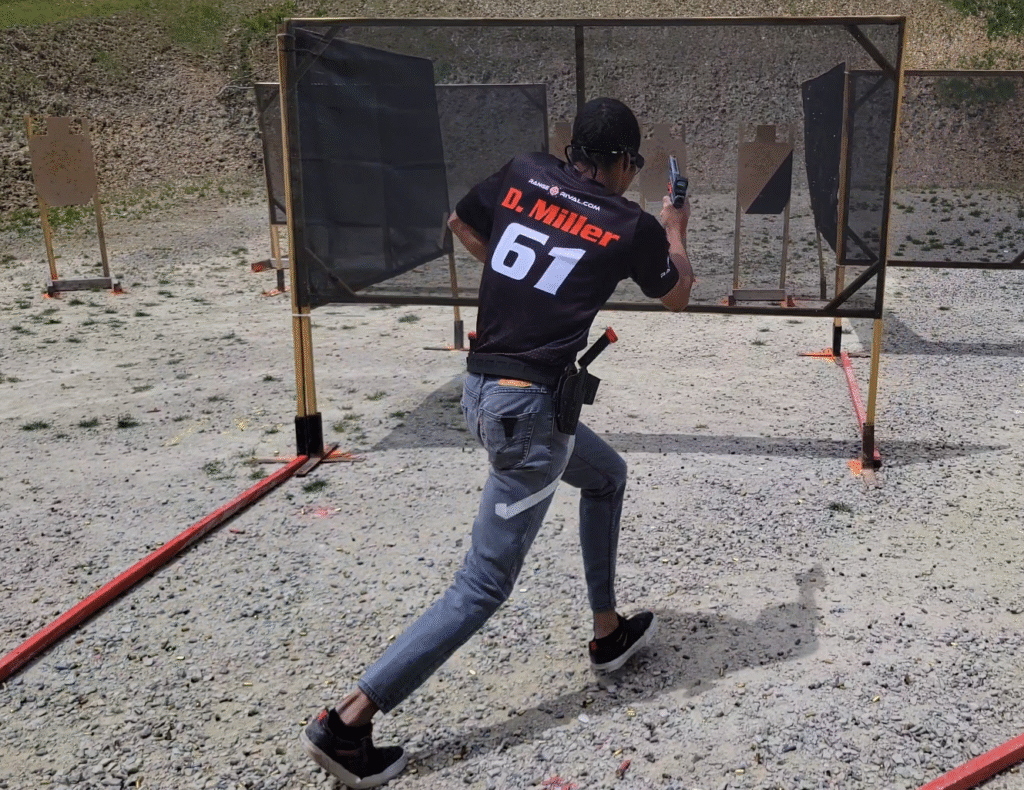Home > On Competition Shooting: Stage Planning
USPSA is a sport in which mechanical skill, planning, and plan execution under duress marry to drive an individual’s performance on a given course of fire. That said, shooting is the easy part I’d say makes up ~10% of the actual game. The other ~90% is stage planning and execution. You can be the best standing, slow-fire shot in the world, but if you can’t integrate those skills into a course of fire, you will not be successful in the sport.
I can vividly recall starting off the sport about a year ago. I was finishing with times that were aggressively low compared to others in my skill tier or FTSA’ing multiple targets. It was all because of a lack of planning. One year later, I’ve been quickly and nearly consistently, finding the more efficient plans and routes that have taken my times from well above the midline to decently below it, and I wanna tell you how. If you feel like there’s something to be desired from your planning, then you’re in the right place.
Before I dig in, I’d like to give a shout out to a fellow competitor, Megan Terry! Terry is the 2025 Michigan Sections CO High Lady, and has given extremely helpful insight into her process. I liked her stage planning process well enough that I’ve now largely adopted it. Let’s get to it!

Do note that there is no sure fire algorithm that will work for everyone. This is just an example of my framework. What’s important is to establish your own that works for you and be consistent about doing it (or steal mine if it works)!
With a framework in hand, let’s explore the elements piece by piece in the context of a stage. Let’s take one of my favorite classifiers: 24-08 And Now For Something Completely Different. The full stage brief can be found at the USPSA website, however the stage layout is as follows.
What’s the first thing that one should do? I thing that you should always read the stage brief a few times. Count the number of targets be aware of the round count. Note the shot rules: Comstock or Virgina? Note the mechanical requirements. Mandatory reloads or one-handed shots? Note the start conditions. Keep these things in mind when walking through the stage. In our example, there are 12 cardboard targets for 24 rounds scored Comstock (best two hits on paper) We start loaded, holstered, wrist below belt, and outside the shooting area with toes touching the rear fault line. On the buzzer we get to work. Simple. Now we scout the targets out.
I cannot express how vitally important it is to walk through a stage and get eyes and a count on your targets. There have been many a stage in my first matches where I didn’t leave the shooting area and forgot targets because I straight up didn’t know they were there. It’s…a “great” feeling.
Nevertheless, you’ll want to inspect the stage from the targets perspective and the shooting area. The former will help build a sense of what your options are for certain targets, especially the hard ones. The latter will begin to establish the route you’re going to take through the stage.
By the time you’ve found all the targets and seen them from multiple perspectives, you’ll have interacted with the stage (hopefully) enough to at least have an idea of the path you’re going to take through the stage. From there, it’s finger guns time!
One thing that screwed me up (and I still see mess other people up), is pacing during early stage walk throughs. Especially on your first serious walkthrough, do everything at no more than about 50% speed: footwork, reloads, engagements. All of it. Count your rounds and count your targets while you’re doing so. Absolutely make sure you hit your target count and round count by the end. If you don’t, figure out what you missed and try again. Over-gassing your actions can result in you finding yourself quickly out of position during execution in the stage, which can even more quickly interrupt the entire flow of your plan. Ask me how I know.
In our stage example, on the buzzer I step just inside the rear fault, and bang T1 and T2 to the immediate left. I then pull the gun around the barrier and press forward, engaging the far target directly in front of me while advancing down the lane. After that, it’s a quick scurry to that interior corner and engaging the array while strafing deeper into the stage. Once the array is burned, I’m running to the forward-close edge of the entry to point to see the array of three targets. I burn them down inside out, leaving on the leftmost target, side stepping towards the upper right edge of the stage to hit a lean around the barrier and burn the last two targets. All this happens at about 50% speed. From here we start adding the details.


By this point you’ll probably have a good idea of where you’re going to shoot from and where you’re not. This is where you start locking down positions of fire (or stretches of moving and firing), minimizing dead space where you’re just moving and figuring out where your reloads are. The sport is highly visual as I outlined in my last article: set up your visual cues. Set up the points you want to land when moving from point to point. Set up the cues for when you should reload, and for where you wanna be. For example, I want to cue myself to the rear edge of port to engage the three target array in the back of the stage.
Continuing the example, we know our stage has 24 rounds. At most, I can carry 20+1. I have to reload somewhere. There are usually multiple options, but there are often some that clearly make the most sense for stage flow.
The first 2 targets are an easy 4 rounds into moving to throwing another 2, now the 6th before I’m in position to start burning the array. There are 4 more targets left in the array, which gets me to 14 rounds after the array. That’s 6 left in the magazine and 10 left in the stage if I take no make up shots. I like to give myself a little insurance where it seems like I could use it. Reloading right after the array when I have dead time running to the next position to present to the three target array in the back left of the stage seems to be the efficient thing to do here.
Theoretically, I could also reload immediately after the first 4 rounds out of the start position. This will leave me with 21 rounds to engage 10 targets with 20 rounds. I would rather have 4 rounds of insurance in the first half of the stage, than 1 round of insurance for 83% of the stage. I’m locking in the former plan for this reason.
If your stage is more complicated, rinse and repeat for the rest of your reloads. Run the stage through at maybe 70% speed with the added mechanics. The main thing to focus on here is optimizing your positions and reloads based on the stage, round counts, and your platform capacity. Stage plans can differ greatly because of that last one. I can attest my stage plans with my Beretta 92FS with a 15 round capacity were quite different sometimes compared to plans with my Canik Rival with a 20 round capacity.
Peak efficiency looks like minimization of time not shooting while simultaneously minimizing your motion and actions while executing a stage. In other words, you want to take care of as much target work as possible, while doing as little mechanical work as possible. This is where people talk about “cutting the slop” out of their execution.
Here are some examples of things to think about during this phase of stage planning:
Run through the stage near 90% speed performing all planned actions and engagements as makes sense. Optimize accordingly.
Try to make the stage flow as smooth as possible, with minimal effort and maximal output. To this end, this penultimate phase of stage planning functionally involves piecing together all the previous data you’ve collected, and forming it into a cohesive and solid plan up to minor adjustments. Run the stage to your plan a few times up to 100% of what you would actually do, and call it. By this point you may still have some time before you’re up to shoot, which takes us to the final preparation step: visualization.
Visualization is one of the more important pieces of the stage planning puzzle. This phase is about seeing the performance in your minds eye, and acting it out if you have some space to do so. Once that 4 minutes is up and you can’t walk through anymore, visualization becomes your best friend. Close your eyes and take yourself through the stage a few times. Once you’re on deck, do it a few more times. Up on the line, give it one more once over and get to work.
There’s an awesome piece of advice in Brian Enos’, “Practical Shooting, Beyond Fundamentals” (an excellent read). Enos states that you should not use your inner voice to tell yourself things like, “reload after the moving array,” or, “plant yourself at the back of the far port,” but rather you should visualize yourself doing these things. Saying the words invokes conscious thought. That conscious thought can then be triggered again in the action of trying to do it (middle of a stage), which will slow you down, reducing efficiency. Visualizing it effectively queues that action up when what you visualize is seen, resulting in more unconscious action. This is far faster than thinking and acting.
For example, for the reload in this stage, I’m visualizing my sights lifting from my second shot on the last target in the middle array. As soon as I see that, my brain fires off the impulses to go for the reload and push towards the next cue.
I can explicitly attest to telling myself, “Don’t miss the reload,” getting to that point in a stage then pausing, saying, “Reload!” in my head, then doing the reload. This delay certainly added time to my stages, by at least a half a second. I’ve recently had more instances when I simply visualize the reload I don’t wanna miss, then execute it seamlessly. Give it a try and I promise the results will speak for themselves.
In summary, the act of stage planning and execution is vitally important to USPSA. The measure we call Hit Factor is a gauge of your ability to do so. Maximizing your Hit Factor largely will involve optimizing your stage planning and sticking to it. Last minute variations will almost always ruin all the work you did prior. This example of a stage planning algorithm looks like:
As long as your fundamentals are good, mastery of stage planning and execution is the other piece of the puzzle. Attaining that mastery is a constant work in progress that I’m most certainly not near mastery of, but rapidly approaching. I hope this article helps you attain that mastery. Thanks for reading!
I vividly recall my first match, and seeing the Level II style stages in our first two bays and going, “how the hell does anyone keep track of all of this?!”. Well about a year later, I think I’ve figured it out. One of the other things I also remember telling myself is that I’m not quite good enough yet to start “cutting the slop” out of my stage plans yet (the small things that result in individual placement differences towards the top). This was only 2 or 3 matches in when I was still learning the ropes, but sure enough in just over a years time, I think I’ve found the formula, and am thankful my recent results have been showing it. Hopefully this helps you push rank! Good luck!
-Devil 6-1